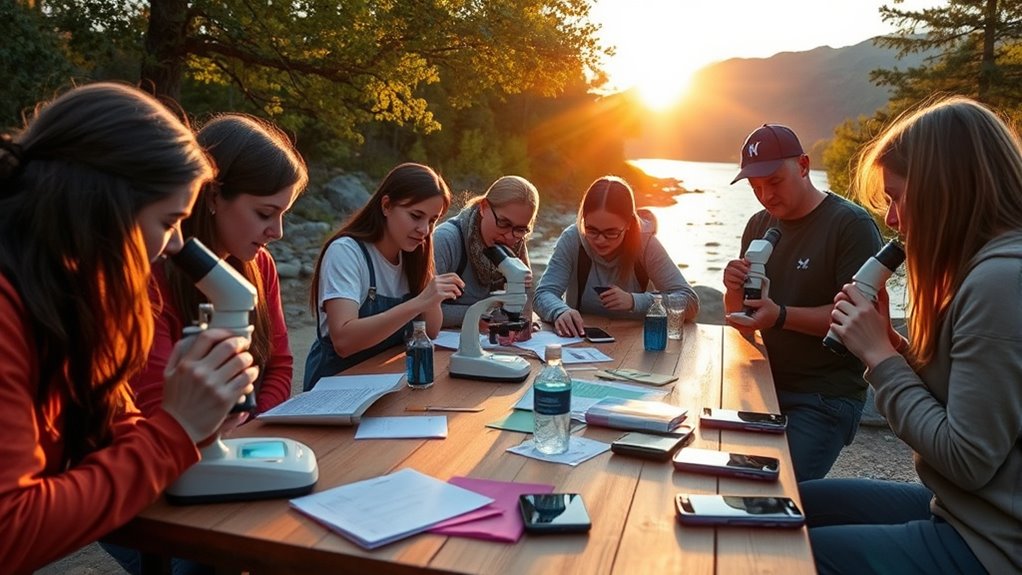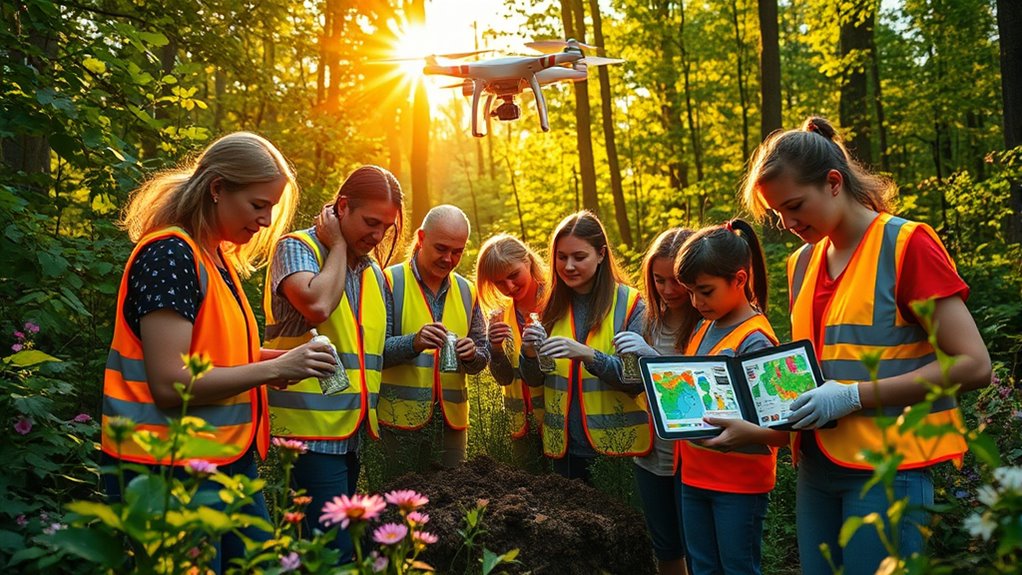Citizen science allows you to directly contribute environmental data that helps protect our planet. By recording bird migrations, water quality, pollution, or taking photographs of environmental issues, your efforts support large-scale scientific research. Your participation accelerates discoveries, tracks ecological changes, and fosters a sense of responsibility. Thanks to technology and clear protocols, your data stays reliable and impactful. Keep exploring, and you’ll discover how your actions truly make a difference in global environmental efforts.
Key Takeaways
- Citizen science data accelerates environmental research and helps identify critical issues needing urgent action.
- Large-scale data collection from volunteers provides comprehensive insights into ecological and climate changes.
- Standardized observations from citizens ensure high-quality data for scientific analysis and decision-making.
- Public participation fosters awareness and collective responsibility for environmental protection efforts.
- Data contributed by citizens supports policy development and effective solutions to environmental challenges.

Have you ever wondered how everyday people can contribute to scientific discoveries? The truth is, you don’t need a lab or advanced degrees to make a real difference. Citizen science empowers individuals like you to participate directly in collecting data that can shape our understanding of the environment, wildlife, and climate. This approach relies heavily on data collection, where volunteers record observations, measure environmental parameters, or track species. Your active involvement turns passive concern into tangible evidence that scientists can analyze. Public participation has become an essential part of scientific research because it vastly expands the reach and scope of data gathering. Instead of a handful of researchers working in isolated locations, thousands of volunteers contribute from their homes, parks, and communities, creating a detailed picture of ecological changes.
Everyone can contribute to science by recording observations, tracking species, and collecting environmental data.
When you get involved, you’re not just helping out; you’re becoming a key part of the scientific process. You might document bird migrations, monitor water quality, or photograph pollution levels. Each data point you provide adds to a larger dataset that scientists use to detect trends, identify problems, and develop solutions. Your participation is especially important because many environmental issues require extensive, continuous monitoring that no single research team could manage alone. By collecting data regularly and consistently, you help scientists track long-term patterns that might otherwise go unnoticed. This collaborative effort accelerates discovery and makes science more accessible to everyone. Additionally, standardized data collection protocols are often provided to ensure accuracy across diverse contributors. Moreover, the use of digital platforms has made it easier than ever for volunteers to contribute data from anywhere in the world.
Public participation also enhances the accuracy and reliability of the data collected. Many citizen science projects include training or guidelines to make sure observations are standardized, which helps maintain quality. When you follow protocols, your contributions are scientifically valuable and can be used confidently alongside professional research. Plus, engaging in these projects fosters a deeper understanding of environmental issues, inspiring a sense of ownership and responsibility. As a participant, you’re not just a bystander; you become an active agent in the effort to protect and preserve the planet.
Furthermore, the integration of smart home technology in everyday life can support citizen science efforts by providing real-time data on utility usage and environmental conditions, making participation even more seamless and impactful. This technological advancement means that citizen scientists can gather more precise data effortlessly, increasing the overall quality of the collective effort.
Ultimately, citizen science demonstrates that science is a collective venture, and your data can have a real impact. Whether you’re tracking local pollution, observing wildlife, or reporting weather anomalies, your efforts contribute to a global pool of knowledge. This collaborative model makes science more democratic and effective, especially when it comes to tackling urgent environmental challenges. So, the next time you see a citizen science project, remember: your data is powerful, and your public participation can help save the planet.
Frequently Asked Questions
How Can I Start Participating in Citizen Science Projects?
You can start participating in citizen science projects by exploring online platforms like Zooniverse or SciStarter, which connect you with various projects. Join project collaborations that match your interests, then learn about different data collection methods used, such as taking photos, recording observations, or logging data. Follow project instructions carefully, contribute your observations regularly, and see how your efforts can help scientists make meaningful discoveries and environmental improvements.
What Skills or Tools Are Needed for Citizen Science Activities?
While you might not need a lab full of equipment, a curious mind and basic skills in data collection and analysis go a long way. You’ll want a keen eye for detail and familiarity with simple tools like smartphones or cameras. These help you gather accurate data and interpret it effectively. With a little practice, you’ll find that your contributions can make a meaningful difference in understanding and protecting our environment.
Are There Age Restrictions for Participating in Citizen Science?
Age restrictions vary depending on the project, but generally, participants of all ages can join citizen science activities. You should follow safety guidelines to guarantee your safety, especially for children or young participants. Many projects welcome family involvement, so check specific age limits and safety instructions before starting. By adhering to these guidelines, you can confidently contribute your data and help make a positive impact on the environment.
How Is Citizen Science Data Verified and Validated?
You might wonder how citizen science data stays reliable. Validation processes involve multiple steps like peer review, cross-checking with expert data, and statistical analysis to guarantee data quality. Your observations are often verified by comparing them with existing datasets or using automated tools. This thorough validation helps confirm accuracy, making your contributions valuable for scientific research and environmental action. Rest assured, your data truly makes a difference!
Can Citizen Science Contribute to Policy Change?
Imagine your data as a rallying cry—your efforts can truly influence policy change. By engaging your community, you create a powerful voice that policymakers can’t ignore. Citizen science contributes to policy influence by providing real, localized data that highlights pressing issues. Your active participation fosters community engagement, making policies more responsive and effective. Together, your data can spark meaningful change and drive environmental and social progress.
Conclusion
By now, you see how your contributions in citizen science can truly make a difference. Every piece of data you share helps scientists understand and protect our planet better. So, why not join the movement and see how your actions can create real change? Your efforts matter more than you realize, and together, we can tackle environmental challenges. Are you ready to help save the planet, one data point at a time?










